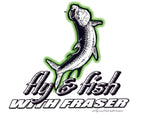How To : Miami Baby Tarpon on Fly and Soft Plastic
Here are some videos and resources for catching Snook and Tarpon here in south Florida General Set Up:
Rods:
Rod: 7 wht.
Leader: 4ft 40lb, 2 ft 30lb, 2ft 20lb, 2ft 50lb
Rod: 9 wht.
Leader: 8ft 50lb butt Section, 2ft 25lb, 2ft -3ft 30-50lb
(We use a 2ft bite tippet so, we can cut and re tie flies many times and it makes it easier to catch the fish. Lengths can vary depending on conditions)
Fly: Craft Fur Bait Fish on 1/0 Hook
In the next video, We are using micro tarpon flies and micro soft plastic paddle tails and travelling by car around south east Florida canals in search of fresh water tarpon. It's June and the summer rains have caused the everglades to over flow and the spillways to the canals have been opened. This causes an extreme amount of water to pass through the locks and spill ways. It also brings a lot of small bait fish with it, causing a tarpon feeding frenzy. As the summer progresses these bait fish eventually wash further out of the canals or down stream and Tarpon and large predators follow. August brings to the intracoastal bridges and Bays an abundance of small fry. Artificial lure and fly selection becomes critical.
In this video, Tarpon on Fly - Dock Lights. Its late summer 100 degrees and the baby tarpon are still here and have been around every dock light in Miami on a consistent basis. Ok, “baby Tarpon”. Well for me, FWC designates 40 inch to be the max size to be removed from the water. Most likely due to a number of factors including and not limited to weight and maturation. Tarpon can grow in excess of 200lb so these guys still have a long way to go in both categories. On my charters on both artificial its not common to get fish under 5-6 ft. So, Baby Tarpon! This week my guest sport angler and I targeted Tarpon around the bridges and lights. In this video We used the following Fly tackle
LINE:
Weight forward floating lines that are usually one line size heavier than the rod calls for, especially on rods with a powerful tip. 99% of our fishing is done with a floating line because the water is clear, shallow and the fish feed on or near the surface aggressively.
Weight forward floating lines. Due to heavy fishing pressure around cities where the small Tarpon are “pounded” daily we use clear slow sinking lines. I like the Scientific Angler Mastery Series Clear if you can pick it up on ebay or the Cortland Clear line is also an option although pricey.
LEADERS:
We use leaders ranging from 8 to 12 feet depending on conditions. when the surface is calm we use longer leaders so the floating line does not spook the fish. We use 20# breaking tippet for the most part so we don’t lose as many flies and so we can strike the fish harder without breaking them off. We use longer (2 feet) shock / bight tippets than IGFA rules allow (sub-12 inches) because we can tie on more flies without having to change shock tippets as much. We also use longer lighter shock tippet in these clear spooky situations. We are using fluorocarbon shock tippet.
Baby Tarpon / Snook/Jacks
4′ of 30# clear hard mason mono for the butt section 2-3′ of 25# for the transition section 2′ of 20# for the breaking tippet 2′ of 30# for the bite/shock tippet. (40-50# fluorocarbon is an option.) **You can adjust these lengths to make the leader longer or shorter depending on the wind.
FLIES:
We are using smaller flies (~2.″) tied with materials that are soft so the flies have more action and look alive. Rabbit strips, soft chicken hackle and turkey marabou plumbs are popular. New soft synthetic furs Like Polar Fiber and Craft Fur are used a lot for our bait fish patterns.
